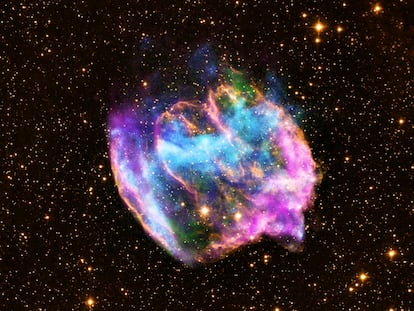Can we know how big a supernova will be before it happens?
The neutron core left after the collapse of a supermassive star determines the magnitude of the stellar explosion

Talking about the size of supernovas is confusing, since they are not objects, they are astronomical events: explosions of stars. There are two types of supernovas, depending on whether their explosion mechanism is gravitational collapse (the more common of the two) or thermonuclear.
Thermonuclear supernovae occur if a white dwarf captures enough mass from another star, causing its core to fuse in a matter of seconds. White dwarfs are very dense objects that form when a star with a mass less than eight times the mass of the Sun has burned up all its fuel. For example, our Sun will eventually become a white dwarf. These stellar remnants have a diameter that is 1% of the Sun’s diameter and a mass similar to that of the Sun and, in many cases, are found in binary systems, close to another star from which they can take mass. When the white dwarf captures mass from the other star, there may come a time, under certain conditions, when its core melts in seconds and causes a shock wave that destroys the star. The luminosity of the white dwarf, which was very small due to the lack of nuclear reactions in its core, increases 100 trillion times. This type of supernova emits the most light because the star is completely destroyed.
Gravitational collapse supernovae occur when the life of a supermassive star (with masses equal to or greater than eight times the mass of the Sun) comes to an end. At the end of their lives, these stars have an iron core surrounded by outer layers of lighter elements. At that moment, the star does not have enough energy to fuse the iron, the balance between the pressure generated by the nuclear reactions (outwards) and the gravitational pressure (inwards) is broken, the core contracts and the outer layers fall onto the center of the star. This causes the nucleus to become very hot and the iron atoms begin to disintegrate, giving rise to a large number of neutrons.
The core becomes increasingly hotter and more iron atoms disintegrate until — in less than a second — all the iron has disintegrated and the core collapses. What remains is a stellar core made up mainly of neutrons that emits a large number of neutrinos, which are very light elementary particles. These particles extract an enormous amount of energy from the star, causing it to cool down. The collapse ends when the neutron density is large enough for the neutron repulsion to stop it. What remains is a neutron core with a radius of between six and 12 miles.
In answering your question, this would be the first size to mention. This nucleus is what we call a neutron star. The size of that nucleus can be estimated using theoretical models. Another outcome for this type of supernova is for it to form a black hole. If the mass of the core is large enough, the neutrons are not able to stop the collapse and, instead of forming a neutron star, a black hole will be created. Due to uncertainties in our theoretical models, the exact limit of the core mass required for a black hole to form instead of a neutron star is not exactly known. In addition to giving rise to a neutron star or a black hole, gravitational collapse supernovas, like thermonuclear supernovae, expel material at enormous speeds. When the outer layers fall inwards on the core, they bounce back and a pressure wave is generated that expels them.
If your question referred more to the extent of the supernova shock wave after the explosion, here we can also make approximate calculations, although it is difficult to be precise because we do not usually have exact data on, for example, the mass of the progenitor star or what exactly is around it. And in addition, we must take into account our lack of understanding of some processes that take place during and after the explosion.
As I mentioned, the explosion of a supernova causes the expulsion of the outer layers of the star by means of shock waves. These stellar residues eventually dilutes in space after millions of years. Before that, there is a period of about 400 years in which the star’s material expands freely at speeds of 6,200 miles per second until the wave front sweeps away a sufficiently large amount of interstellar material, equal to the mass of the star layers in that wave front. When that happens, the expansion begins to slow down. In that time, the material has traveled about 10 light-years (1 light-year is 5.88 trillion miles).
Then, the expansion rate slows down as more and more material is dragged along without losing much energy. This ends when about 100,000 years have passed. Up to this point, the shock wave emits energy in different ranges of the electromagnetic spectrum (which can be observed by our telescopes). This phase ends when the wavefront begins to radiate enough light to lose energy, which causes it to cool down until 1 million to 10 million years have passed since the explosion. Then, the remnant stops expanding and dilutes in the interstellar medium. By that point, it has traveled about 300 light-years.
Marina Cermeño Gavilán is a doctor in Theoretical Physics and a researcher at the Institute of Theoretical Physics of Madrid UAM-CSIC.
Question sent via email by Angel Lino Bayugar.
Coordination and writing: Victoria Toro.
Tu suscripción se está usando en otro dispositivo
¿Quieres añadir otro usuario a tu suscripción?
Si continúas leyendo en este dispositivo, no se podrá leer en el otro.
FlechaTu suscripción se está usando en otro dispositivo y solo puedes acceder a EL PAÍS desde un dispositivo a la vez.
Si quieres compartir tu cuenta, cambia tu suscripción a la modalidad Premium, así podrás añadir otro usuario. Cada uno accederá con su propia cuenta de email, lo que os permitirá personalizar vuestra experiencia en EL PAÍS.
¿Tienes una suscripción de empresa? Accede aquí para contratar más cuentas.
En el caso de no saber quién está usando tu cuenta, te recomendamos cambiar tu contraseña aquí.
Si decides continuar compartiendo tu cuenta, este mensaje se mostrará en tu dispositivo y en el de la otra persona que está usando tu cuenta de forma indefinida, afectando a tu experiencia de lectura. Puedes consultar aquí los términos y condiciones de la suscripción digital.










































